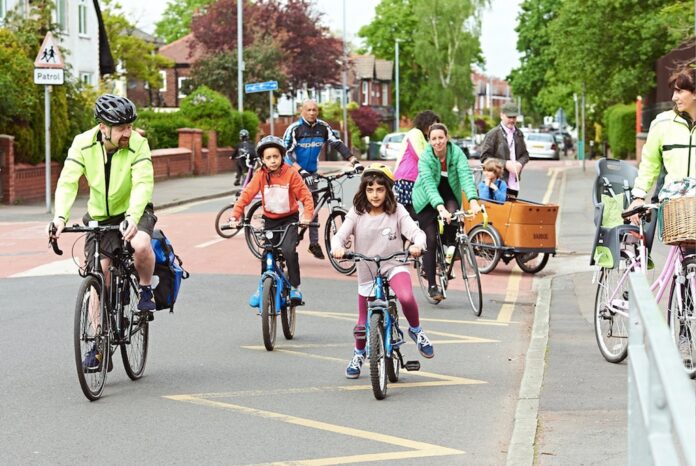New research conducted by the University of Salford, looking at the impact of Active Neighbourhoods, has recommended the prohibition of pavement parking and the introduction of safe school streets measures to help support people to cycle and walk more for local journeys.
The study, which has been supported by Transport for Greater Manchester (TfGM) and the Higher Education Innovation Fund (HEIF), saw researchers engaging with residents in four Active Neighbourhoods – or ‘low traffic neighbourhoods’ – to understand the impact of walking and cycling interventions from the perspective of diverse communities.
Active, or Low Traffic neighbourhoods are an attempt by local authorities to make it easier for people to walk and cycle in residential areas by removing through traffic and creating more pleasant places to spend time. The technique has been widely applied in London and other cities, and has now been introduced in a number of locations in Greater Manchester.
The areas selected for study reflected different Greater Manchester districts and included Trinity and Islington (Salford), Levenshulme (Manchester), Garside Hey Road (Bury) and Cheadle Heath Active Neighbourhood (Stockport).
Findings from the research showed that participants felt conditions for cycling on local roads had improved, but felt more could be done to improve walking conditions.
Comments from participants highlighted that there is often a lack of space on pavements due to high levels of parking, causing difficulties for disabled people and people with children or prams.
To help tackle this the research recommends pavement parking should be prohibited as part of active neighbourhood projects, referring to the successful prohibition of pavement parking in 32 London boroughs, and the City of London.
The report also recommends more “School Streets” schemes are rolled out in Active Neighbourhoods in Greater Manchester, to help support parents who might want to cycle or walk to school with their children by closing roads outside schools to motor traffic at school drop-off and pickup time.
These programmes help to improve road safety around schools, reduce anti-social behaviour associated with parking and poor driving and ultimately reduce traffic on the school run. TfGM is currently running a programme allowing for up to 50 School Streets will be delivered by Greater Manchester’s ten local authorities.
To ensure broad community involvement in the development of inclusive, accessible active neighbourhoods, further engagement was suggested at the outset of scheme development with community groups, older people and disabled people to ensure they can help share any concerns and help to shape the plans. Other recommendations included setting up Active Neighbourhood forums and communicating monitoring and evaluation measures.
Richard Nickson, Programme Director for Cycling and Walking at TfGM said: “Simply put, Active Neighbourhoods are places where people are prioritised over cars. They’re safe spaces where people can chat and kids can play out – and it’s also easier to get around on foot or by bike.
“They also link into Greater Manchester’s vision for a joined-up Bee Network, linking cycling and walking with buses, trains and Metrolink services. Measures like banning pavement parking and introducing more School Streets can have real advantages so it’s great that the study picked up on these points.
“But we do also know that people may have questions or concerns, and it’s great we have also had feedback about what we can do to ensure our engagement is even better. That is why studies of this nature are critical – along with listening to people’s feedback – so we know what we can do to improve.”
Harriet Larrington-Spencer, researcher for Healthy Active Cities in the School of Health and Society at the University of Salford, said: “Looking at better use of road space to encourage walking and cycling within cities is essential to tackle the climate crisis, as well as to help people to keep active.
“The question isn’t really whether we reallocate road space, but how we do it to make sure that we support people who might otherwise face barriers in accessing their local neighbourhoods such as disabled and older people, and, increasingly, children.”







